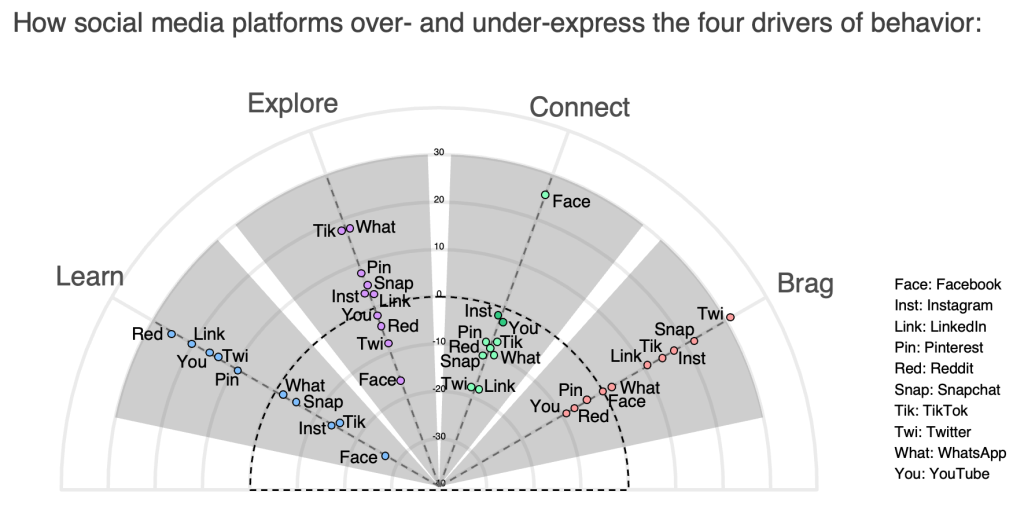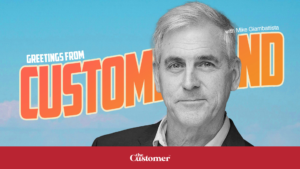by Mary Mathes, Rosalie Samide, PhD
This article originally appeared in ANA
The term “social media” implies purposes like connecting with others, socializing, sharing, and bonding. While this is certainly one reason a person may engage with social media, from its earliest days several other motives have consciously or unconsciously driven users to partake. Our research among nearly 4,000 U.S. respondents between the ages of 18 and 75 reveals that out of 10 top social media platforms today, only one is primarily associated with serving social connection: Facebook.
There are four core motivations people can have for engaging with the various platforms. These may or may not be conducive to them noticing a brand’s content while on a given platform. In short, the four reasons people use social media are: to learn and find information, to connect with others and/or tap into their recommendations, to explore, escape, take a mini mental vacation, or to brag about their accomplishments, possessions, and generally show off how great their life is.
A quick scroll through your feed will likely quickly surface examples of each:
- Learn: If you’re scrolling for how-to videos, articles about top vacation destinations for 2023, or new slow cooker recipes, you’re probably in learning mode.
- Connect: That friend who’s always asking their network what show they should watch next, or reminiscing about “that one time at band camp” with their old high school buddies? They are seeking social connection; they value the “wisdom of the tribe” and being a part of their group.
- Explore: If you like perusing your friends’ spring break pictures so you can imagine yourself at the beach, or watching cute animal videos, then you’re likely there to explore and take a mini mental break.
- Brag: The friend who’s off on yet another fabulous vacation, or sharing pictures of their child’s Ivy League college acceptance? They’re showing off.
All four behavioral drivers can exist on any given platform, but deep down, users have figured out which platforms best serve each. They subconsciously associate different sites with different emotional “jobs to be done” when they use (or don’t use) a particular medium. Let’s examine which of the top social media platforms users associate with each drive, and what that can tell us about what role brands can and should play there.
Learning: YouTube (regularly used by 66 percent of adults according to a study we fielded in February 2023), Reddit (used by 11 percent), and LinkedIn (used by 14 percent) are primarily associated with learning and finding information.
Social connection: Facebook is truly about connecting and bonding with others; it is the only platform that is primarily associated with the ostensible purpose of “social” media. Two-thirds of U.S. adults regularly use Facebook.
Exploration and escape: This drives engagement with TikTok (used regularly by 34 percent of U.S. adults), WhatsApp (21 percent), and Pinterest (18 percent).
Showing off and bragging: this is the primary purpose of Twitter (used by 28 percent of all U.S. adults), Snapchat (21 percent), and Instagram (39 percent).

Source: Alpha-Diver OmniPulse studies fielded in October 2023 among a U.S. rep pop sample ages 18-75. n = 3,994.
As you can see in this visualization, some platforms do over-index on more than one driver. Twitter is most associated with bragging, but for some it also serves the desire for learning. Similarly, TikTok is most strongly associated with exploration, but also can be a means for bragging. What is perhaps most notable is the Connect “neighborhood“: Facebook stands alone in over-expressing this drive; all other platforms under-index on connection.
The true, subconscious reason someone engages with a given digital medium matters, and as our data shows, that reason isn’t the same across all platforms. This is why, for example, some people find it jarring when they see more personal or family-focused posts on their LinkedIn feed. In their mind, these connection-focused posts “don’t belong” there because they don’t fit with why they’re using LinkedIn.
Advertising that doesn’t “fit” the job of the platform it appears on can be similarly off-putting or risks just being ignored. So, a given brand’s content likely doesn’t belong on all platforms, nor should it be the same across all.
Considering your brand and product, as well as the message you’re trying to send, what platform(s) logically fit? Alternatively, if you’re determined to advertise on Facebook because that’s where the eyeballs are, think about how to tweak your approach to align with the connection-focused nature of the platform, while your YouTube content can be more educational and informative. Understanding what motivates your target consumers when they engage with each platform provides a significant unlock in your media planning strategy to drive greater engagement by reaching consumers in the right mindset to receive your message.





